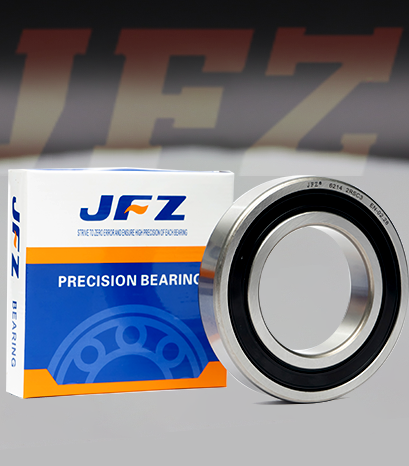1 Bearing usage conditions and problems
607 Insert spherical deep groove ball bearings are used in a multi-function tool. The working principle of the multi-function tool (Figure 1) is: the motor rotates at high speed, due to the eccentricity between the axis of the mating part of the rotor and the outer spherical bearing and the rotation axis of the motor. , causing the outer spherical bearing to drive the shift fork to swing at high frequencies with the output shaft as the center of rotation, thereby causing the saw blade, grinding head, etc. fixed on the output shaft to swing at high frequencies. Swing for several times to achieve functions such as cutting and grinding.

1—Output shaft; 2—Output shaft rear bearing; 3—Shift fork; 4—607 outer spherical bearing;
5—Rotor front bearing; 6—Rotor; 7—Rotor rear bearing; 8—Output shaft front bearing;
9—Screw; 10—Saw blade
Figure 1 Working principle diagram of multi-function tool
When the bearing was subjected to relevant life tests, the polyamide cage broke and the bearing loose sleeve failed after only running for 15 to 30 hours, as shown in Figure 2.

Figure 2 Picture of early bearing failure
2 Failure cause analysis
Combined with the actual application conditions and failure modes of the bearing, the analysis shows that the main reasons for the early failure of the bearing are the following two aspects: (1) During the operation of the bearing, there is strong impact and friction between the outer ring and the shift fork, resulting in greater Too much heat will increase the temperature of the bearing, and the PA66 reinforced polyamide cage will age and reduce its strength at high temperatures; (2) There is a large impact force between the bearing outer ring and the shift fork, causing the outer ring to undergo rigid deformation and poly The amide cage is subject to a certain impact force.
3 improvement measures
For the above two reasons, on the one hand, the surface roughness of the relevant contact surface is improved to reduce friction and heat; on the other hand, the structural parameters of the bearing are adjusted to increase the rigidity of the bearing and reduce the maintenance cost.
The impact force on the cage is reduced, while the strength of the cage is increased.
3.1 Improvement of cage
The original cage adopts the reinforced polyamide cage structure of 607 sealed deep groove ball bearings, and the pocket bottom diameter thickness S = 0. 35 mm, as shown in Figure 3. Since the 607 outer spherical deep groove ball bearing designed in this article is an open structure, S can be increased to 1 without changing the overall dimensions of the bearing. About 1 mm to enhance the strength of the cage. The newly improved cage was used for installation tests, and the bearing life was increased from the previous 15 to 30 hours to 40 to 80 hours.
3. 2 Improvement of main parameters of bearings
The number of steel balls in the improved bearing remains unchanged (7), and the diameter of the steel balls is changed from 3. 5 mm adjusted to 3. 175 mm, the pitch circle diameter of the ball group is adjusted from 13 mm to 12. 5 mm, the filling angle is reduced from 187° to 176°. In Figure 4, B = (D - Dpw - Dw) /2, D is the outer diameter of the bearing, D = 19 mm. Substituting relevant parameters, B is calculated from 1 before improvement. 25 mm increased to 1.66 mm. This change greatly enhances the rigidity of the outer ring and prevents it from colliding with the shift fork.
It is easy to deform, thereby eliminating the impact on the cage due to the deformation of the outer ring and avoiding damage to the cage.


Figure 3 Cage structure Figure 4 Outer ring structure diagram
4 Conclusion
After the bearing structure was redesigned, the rigidity of the outer ring was strengthened, which greatly helped improve the bearing life. Theoretically, reducing the diameter of the steel ball will reduce the rated load and rated life of the bearing, but in practice the bearings in use all suffer from early abnormal failure. The reduction of the steel ball diameter improves this situation, which is conducive to increasing the actual working life of the bearing. The improved bearing was used for installation testing and the service life reached 80 to 120 hours, which basically met the working requirements.
JFZ Deep Groove Ball Bearing

JFZ Deep Groove Ball Bearing is a high-quality bearing designed to meet the diverse needs of industrial applications. The bearing is made from premium-grade materials and is engineered to withstand the rigors of heavy-duty operations. With deep grooves that enable the bearing to handle both radial and axial loads, JFZ Deep Groove Ball Bearing offers superior performance and reliability. The bearing can operate at high speeds and temperatures with minimal wear and tear, making it ideal for use in a wide range of applications.
JFZ Deep Groove Ball Bearing is suitable for use in machinery and equipment such as pumps, motors, gearboxes, and conveyor systems. It is also widely used in the automotive and aviation industries for applications ranging from wheel bearings to aircraft engines. The bearing features a simple design that allows for easy installation and maintenance. It is available in a variety of sizes and configurations to cater to different application requirements.

















